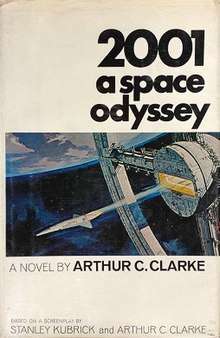2001: A Space Odyssey
2001: A Space Odyssey is the 1968 science fiction novel written by Arthur C. Clarke and the 1968 film directed by Stanley Kubrick. It is a part of Clarke's Space Odyssey series. Both the novel and the film are partially based on Clarke's 1948 short story "The Sentinel", an entry in a BBC short story competition, and "Encounter in the Dawn", published in 1953 in the magazine Amazing Stories.

.png)
Resources
After deciding on Clarke's 1948 short story "The Sentinel" as the starting point, and with the themes of man's relationship with the universe in mind, Clarke sold Kubrick five more of his stories to use as background materials for the film. These included "Breaking Strain", "Out of the Cradle, Endlessly Orbiting...", "Who's There?", "Into the Comet", and "Before Eden".[1] Additionally, important elements from two more Clarke stories, "Encounter in the Dawn" and (to a somewhat lesser extent) "Rescue Party", made their way into the finished project.[2] One other element (crossing vacuum without an intact pressure suit) is from the short story "Take a Deep Breath".
Development
Clarke was originally going to write the screenplay for the film, but this proved to be more tedious than he had anticipated. Instead, Kubrick and Clarke decided it would be best to write a prose treatment first and then adapt it for the film and novel upon its completion.
Clarke and Kubrick jointly developed the screenplay and treatment, which were loosely based on The Sentinel and incorporated elements from various other Clarke stories. Clarke wrote the novel adaptation independently. Although the film has become famous due to its groundbreaking visual effects and ambiguous, abstract nature, the film and book were intended to complement each other.
Film
The film was written by Clarke and Kubrick and featured specialist artwork by Roy Carnon.[3] The film is notable for its scientific realism, pioneering special effects, and provocatively ambiguous imagery and sound in place of traditional narrative techniques.
Despite receiving mixed reviews upon release, 2001: A Space Odyssey is today thought by some critics to be one of the greatest films ever made and is widely regarded as one of the best science fiction films of all time. It was nominated for four Academy Awards, and received one for visual effects. It also won the Kansas City Film Critics Circle Best Director and Best Film awards of 1968. In 1991, 2001: A Space Odyssey was deemed culturally significant by the United States Library of Congress and selected for preservation in the National Film Registry.
Score
A musical score was commissioned for the film and composed by Alex North, but Kubrick ultimately decided not to use it, in favour of the classical pieces he used as guides during shooting. These included Richard Strauss's "Also Sprach Zarathustra", Johann Strauss' "Blue Danube Waltz", and music by twentieth-century composers Aram Khachaturian and Gyorgy Ligeti.
Toward the end of the sequence where the HAL 9000 computer is lobotomized, it begins to play the 1892 song "Daisy Bell (Bicycle Built for Two)" by Harry Dacre, which Clarke had seen a demonstration of computer synthesis on an IBM 704 at Bell Labs in 1961. The rendition is gradually slowed down to a progressively lower sample rate, which then creates a strikingly electronic, distorted, basso profundo.
Novel
Arthur C. Clarke wrote the novel. He developed it concurrently with the film version and published it in 1968, after the film's release. The Lost Worlds of 2001 (1972) elaborates on Clarke and Kubrick's collaboration.[4]
The novel has numerous differences from the film. Most notably, the setting for the part three (of four) in the book is not Jupiter, as in the film, but Saturn.
Comics
2001: A Space Odyssey was the name of an oversized comic book adaptation of the 1968 film of the same name and a 10-issue monthly series "expanding" on the ideas presented in the film and the eponymous Arthur C. Clarke novel. Jack Kirby wrote and pencilled both the adaptation and the series, which were published by Marvel Comics beginning in 1976.
The Space Odyssey series
The Space Odyssey series is a science fiction series of four novels, primarily written by the science-fiction writer Arthur C. Clarke, and two films, released from 1968 to 1997. Stanley Kubrick directed the first film, 2001: A Space Odyssey (1968). He also co-authored the treatment and screenplay with Clarke, based on the seed idea in an earlier short story by Clarke (which bears little relation to the film other than the idea of an alien civilisation's having left something to alert them to mankind's attaining the ability to space travel). Clarke's novel 2001: A Space Odyssey was published in 1968. Kubrick had no involvement in any of the later projects.
Peter Hyams directed the second film, 2010 (1984). He also wrote the screenplay based on Clarke's novel, 2010: Odyssey Two (1982). Clarke was not directly involved in Hyams' film's production as he had been with Kubrick's film, although he did appear in a cameo role in the finished film, sitting on a park bench feeding birds outside the White House.
References
- Arthur C. Clarke, The Lost Worlds of 2001, p. 32
- Arthur C. Clarke, The Collected Stories of Arthur C. Clarke in the preceding notes to each story
- Hughes, David (2000). The Complete Kubrick. Random House. p. 94. ISBN 9781448133215. Retrieved 12 December 2017.
- Arthur C. Clarke (1972). The Lost Worlds of 2001. Signet.